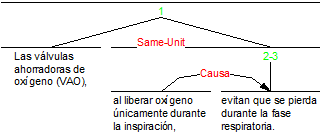The relations used for the annotation of texts should be:
| Nucleus-Satellite Relations |
Multinuclear Relations |
| Elaboration |
Union |
| Evidence |
Contrast |
| Enablement |
List |
| Background |
Sequence |
| Result |
Disjunction |
| Justify |
Conjunction |
| Concession |
|
| Means |
|
| Purpose |
|
| Otherwise |
|
| Antithesis |
|
| Cause |
|
| Condition |
|
| Motivation |
|
| Interpretation |
|
| Circumstance |
|
| Evaluation |
|
| Reformulation |
|
| Summary |
|
| Solution |
|
| Preparation |
|
| Unconditional |
|
| Unless |
|
Regarding the "overlapping" units, the Same-Unit relation will be used, in the manner shown by the following example (extracted from da Cunha and Iruskieta, 2010):

To obtain a list of examples for all the relations here listed, we recommend the following article:
da Cunha, Iria: Iruskieta, Mikel (2010). «Comparing rhetorical structures of different languages: The influence of translation strategies». Discourse Studies 12(5). 563-598.
